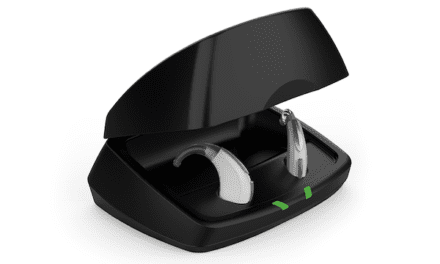Tech Topic | March 2021 Hearing Review
By Erik Harry Høydal, MSc; Niels Søgaard Jensen, MSc, Christina Hakvoort, MBA, and Brian Taylor, AuD
A survey of 56 patients who compared the performance of the Signia Xperience Pure 312 7X hearing aids with their previous hearing aids found satisfaction ratings significantly higher for the Signia devices and also considerably higher than a recent (2018) EuroTrak survey that utilized many of the same survey questions. Wearer preference for Xperience was strong across common listening demands: speech understanding, listening effort, and overall preference. The results demonstrate Xperience wearers can expect high levels of satisfaction, a critical component of long-term success.
Signia has a long history of innovative solutions resulting in improved patient benefit, especially for listening in background noise. One example is Signia’s bilateral beamforming directional microphone system, Narrow Directionality, that enables many hearing aid wearers to understand speech in noise better than individuals with normal hearing.1
In 2019, Signia launched Xperience, a device with several new features, including acoustic motion sensors. In a laboratory-based study, Froehlich et al2 demonstrated that Xperience wearers received clinically significant benefit in four distinct areas:
- Understanding speech in background noise,
- Understanding talkers from the side,
- Understanding talkers while in motion,
- Reduced listening effort when the new Xperience features were activated.
Additionally, when Signia hearing devices are compared head-to-head with other similar devices from leading manufacturers, recent clinical research indicates Signia devices result in significantly better performance in three key areas:
- Speech understanding ability in three different types of background noise;3
- Feedback reduction,4 and
- Naturalness of the wearer’s own voice.5
These three documented benefits from independent labs are present in the Xperience product line. Further, as previously mentioned, Xperience has several new features, two of which also have been shown to lead to higher levels of patient satisfaction2:
- An enhanced signal classification system to improve identification and analysis of the wearer’s acoustic scene. This advanced system, Dynamic Soundscape Processing, considers such factors as: overall noise floor; distance estimates for speech, noise, and environmental sounds; the calculated signal-to-noise ratios; estimates of the azimuth of the primary speech signal, and determination of ambient modulations in the wearer’s acoustic soundscape.
- Another addition to Xperience is motion sensor technology, designed to assist with the signal classification of Dynamic Soundscape Processing. Known as Acoustic-Motion Sensors, this new feature adapts sound processing within the hearing device when wearer movement is detected.
Given the addition of these new features, synchronized with other above mentioned innovations from Signia, there is potential for higher levels of wearer satisfaction in challenging listening situations. Although satisfaction is not necessarily equated with benefit, recall that previously cited laboratory studies have confirmed several types of wearer benefits associated with implementation of these features. The question this study attempts to address, however, is twofold:
- Do these new Signia features translate into higher levels of wearer satisfaction?
- Do these new features provide additional improved wearer outcomes in critical listening situations compared to other hearing aids?
To answer these two questions and further validate improved wearer outcomes derived from Signia Xperience, a multi-site satisfaction survey was administered to a group of experienced hearing aid wearers. The survey was conducted by several hearing care providers located in three different countries: the United States, South Africa, and Germany.
Methods
Participants. All participants (n=56) had bilateral, symmetric hearing losses and were experienced full-time hearing aid wearers who did not report problems with their current hearing aids. There were 39 males and 17 females. The majority of the participants were retired (57%). All participants demonstrated they were able to access and navigate the online satisfaction survey via their own laptop computer or smartphone device.
Hearing aids. The experimental hearing aids used in the study were Signia Xperience Pure 312 7X, fitted using the Connexx software 9.1 to the X-Fit rationale. Click sleeve and click dome couplings were used, selected by the hearing care provider to be appropriate for each participant’s hearing loss. Own Voice Processing (OVP), a feature designed to minimize problems associated with the hearing aid wearer’s own voice, was activated. Other special features were set to default. Fine-tuning of the devices by the provider was conducted as needed and was reported to be minimal.
Comparison instruments. The comparison instruments were the participant’s own hearing aids. No changes in the programming of these devices were conducted by the provider. The participants were wearing instruments from all major hearing aid manufacturers. A total of 71% of the participants reported they wore their hearing aids at least 10 hours/day.
Procedure. Participants were recruited by the clinics of the participating hearing care providers. The study began with baseline satisfaction survey ratings for the participant’s own hearing aids, and over the next 7 weeks the participants completed an additional satisfaction survey for their own instruments. In addition, two satisfaction surveys that gathered wearer responses on their use of the Xperience device were completed.
The satisfaction survey included ratings for 12 different listening situations/attributes and an overall rating of satisfaction. The ratings for these questions were modeled after MarkeTrak/EuroTrak, using a 7-point Likert-type scale ranging from 1=Very Dissatisfied, 4=Neutral, to 7=Very Satisfied.
Three additional questions related to wearer preference required the participants to choose between their own hearing aids and the Xperience devices for listening effort, speech understanding, and overall preference. The specific ordering of device use and survey administration is summarized below:
Day of Fitting
- Complete satisfaction survey for own hearing aids;
- Fitted with Xperience hearing aids;
- Use Xperience hearing aids for 3 weeks.
Week 3
- Complete online satisfaction survey for Xperience hearing aids;
- Switch back to own hearing aids;
- Use own hearing aids for 2 weeks.
Week 5
- Complete online satisfaction survey for own hearing aids;
- Switch back to the Xperience hearing aids;
- Use Xperience hearing aids for 2 weeks.
Week 7
- Complete online satisfaction survey for Xperience hearing aids;
- Complete 3-question preference survey to determine overall hearing aid preference.
Results
The mean score for each survey question was calculated for both the participants’ own hearing aids and the Xperience devices. Only the ratings from the second time each participant completed the survey (ie, at Week 5 and Week 7) were included in the statistical analysis. This represented direct back-to-back comparisons of the two devices, as well as the longest wearing time of each device. Analyzing the mean results in this manner was expected to be the most valid way to measure wearer satisfaction. The results, shown in Figure 1, indicate a clear advantage for the Xperience device compared to their current hearing aid. Note that, in general, satisfaction was increased by one full category of improvement on the 7-point scale for the Xperience device. For all 12 items on the questionnaire, the improvement provided by Xperience was significant at the p<.01 level.

Another way to examine the findings from the satisfaction survey is to determine the percentage participants who had a “top-3 box satisfaction” rating for each survey item for the two hearing aid conditions. This is the sum of the ratings of #5 (somewhat satisfied), #6 (satisfied), and #7 (very satisfied). This top-3 box approach is commonly used by both MarkeTrak and EuroTrak. The results of this analysis are shown in Figure 2. Consistent with the results shown in Figure 1, note the substantially higher top-3 box satisfaction scores for all 12 items on the survey for Xperience compared to the participant’s own hearing aids.
Figure 2 shows a clear advantage for the Xperience device across all items on the survey. While all of these advantages are quite large, notice that four items have a greater than 40% advantage for Xperience: speech from behind, speech understanding in a car, speech-in-noise while walking outside, and ability to hear soft speech.

Another way to examine differences in wearer satisfaction is to compare Xperience satisfaction ratings to previously published, standardized surveys such as EuroTrak. Four of the items on the satisfaction survey used in this study were the same as used in EuroTrak surveys. If we compare a recent EuroTrak survey conducted in Germany (Eurotrak Germany 2018),6 substantially higher satisfaction percentages for Xperience are noted for all areas queried on the survey: Satisfaction with Xperience was higher for understanding TV (86% vs 76%), understanding in a car (89% vs 78%), and comfort for loud sounds (82% vs 66%). The largest difference was for “natural sounding” where the EuroTrak survey yielded a score of 71%, while the satisfaction score with Xperience was 89%.
Although this study shows a decided advantage for Xperience on all conditions and attributes of satisfaction compared to participants’ own hearing aids, there are a few areas of improvement in which Xperience stood out that warrant further consideration and could be attributed to new features. Given the markedly better satisfaction scores for Xperience relative to the participants’ own hearing aids for both speech from behind and speech in the car (where the talker is seldom directly in front of the wearer), it is likely Dynamic Soundscape Processing and Acoustic-Motion Detection are contributing to these higher wearer satisfaction scores in these frequently encountered real-world listening situations.
Another expected advantage of Dynamic Soundscape Processing and Acoustic Motion Sensors is understanding speech in noise when the wearer is walking outside. This study found a sizeable advantage in satisfaction scores for Xperience in this situation. This is a wearer advantage, documented in previous research published in the November 2019 Hearing Review, which leads to higher levels of wearer satisfaction.2 Acoustic motion sensor technology was not present in any comparison hearing aids worn by the participants, which likely explains these considerable advantages for Xperience in situations when an individual is walking.
Perhaps the most clinically relevant advantage for Xperience, when compared to the participant’s own hearing aids in this study, was the markedly increased wearer satisfaction for the ability to hear soft sounds. A hearing aid attribute sometimes overlooked, hearing soft sounds are a virtually universal need, as opposed to riding in the car, the need to hear speech from behind, walking around, etc. Several features are likely to be contributing to this advantage for hearing soft sounds. First, Signia’s signal Dynamic Soundscape Processing system is enhancing the wearer’s auditory scene, including the ability to detect soft speech from all directions. Second, it is possible that the Signia X-Fit fitting formula, when combined with the provider’s ability to verify a reasonable match of a prescribed gain target, provides more audibility for soft sounds than the algorithm used in the participants’ own hearing aids. Third, Signia’s industry-leading feedback reduction algorithm enables wearers to obtain more aided gain for soft sounds without encountering feedback.
Finally, three additional preference questions were asked to the 56 study participants (Figure 3). Note that more than 70% of participants preferred the Xperience for both reducing listening effort and improving speech understanding. Also, as Figure 3 shows, overall preference drastically favored Xperience.

In addition to completing three survey questions about preferences, all participants made notes regarding why they preferred one device over the other. It is important to point out that several of the participants who stated a preference for their own hearing aids expressed that they did so because the physical fit or ear coupling for the Xperience was uncomfortable, and they preferred the physical comfort of their own hearing aids. This issue is not unexpected and something readily addressed in everyday clinical practice, thus an even larger preference for Xperience might be expected.
Summary
One of the most important aspects of hearing aid outcomes is satisfaction. It is perhaps best defined as a positive emotional experience related to the performance and use of hearing aids. The importance of patient satisfaction in hearing healthcare is evidenced by the fact that it is frequently included as a measure of outcome, including more than 30 years of MarkeTrak surveys.7 From a patient’s perspective, satisfaction is crucial to the hearing aid acquisition and wearing experience. After all, even when there is evidence of patient benefit, if patients are not satisfied with their devices, they are more likely to stop wearing them.
The results of the survey revealed high wearer satisfaction ratings of Signia Xperience devices for all the listening conditions and sound attributes assessed—satisfaction ratings that were significantly higher than those from the participants’ own hearing aids and considerably higher than a recent EuroTrak survey. These hearing aids offer new signal processing features that improve identification and analysis of the wearer’s acoustic scene, as well as the use of acoustic motion sensor technology. When compared to their own hearing aids, wearers reported the highest satisfaction and preference scores for the Xperience device. Moreover, the largest advantages found for the new devices were in particularly demanding listening situations, such as understanding speech while in the car and walking.
Lastly, when asked to state their preference between Xperience and their own hearing aids, a clear majority of the participants chose Xperience. Wearer preference for Xperience was strong and consistent across common listening demands: speech understanding, listening effort, and overall preference. Results of this study demonstrate Xperience wearers can expect high levels of satisfaction, a critical component of long-term success.

References
- Froehlich M, Freels K, Powers TA. Speech recognition benefit obtained from binaural beamforming hearing aids: Comparison to omnidirectional and individuals with normal hearing. AudiologyOnline. https://www.audiologyonline.com/articles/speech-recognition-benefit-obtained-from-14338. Published May 28, 2015.
- Froehlich M, Branda E, Freels K. New dimensions in automatic steering for hearing aids: Clinical and real-world findings. Hearing Review. 2019;26(11):32-36.
- Branda E, Powers T,A Weber J. Industry research: Clinical comparison of premier hearing aids. Canadian Audiologist. 2019;6(4).
- Marcrum SC, Picou EM, Bohr C, Steffens T. Feedback reduction system influence on additional gain before feedback and maximum stable gain in open-fitted hearing aids. Int J Audiol. 2018;57(10):737-745.
- Froehlich M, Powers TA, Branda E, Weber J. Perception of own voice wearing hearing aids: Why “natural” is the new normal. AudiologyOnline. https://www.audiologyonline.com/articles/perception-own-voice-wearing-hearing-22822. Published April 2018.
- European Hearing Instrument Manufacturers Association (EHIMA) and ANOVUM. EuroTrak Germany 2018. https://www.ehima.com/wp-content/uploads/2018/06/EuroTrak_2018_GERMANY.pdf.
- Kochkin S. MarkeTrak VIII: 25-year trends in the hearing health market. Hearing Review. 2009;16(11):12-31.
Correspondence to Erik Harry Høydal at: [email protected].
Citation for this article: Hoydal EH, Jensen NS, Hakvoort C, Taylor B. Signal processing strategies that improve real- world satisfaction in key listening situations. Hearing Review. 2021;28(3):22-24.





